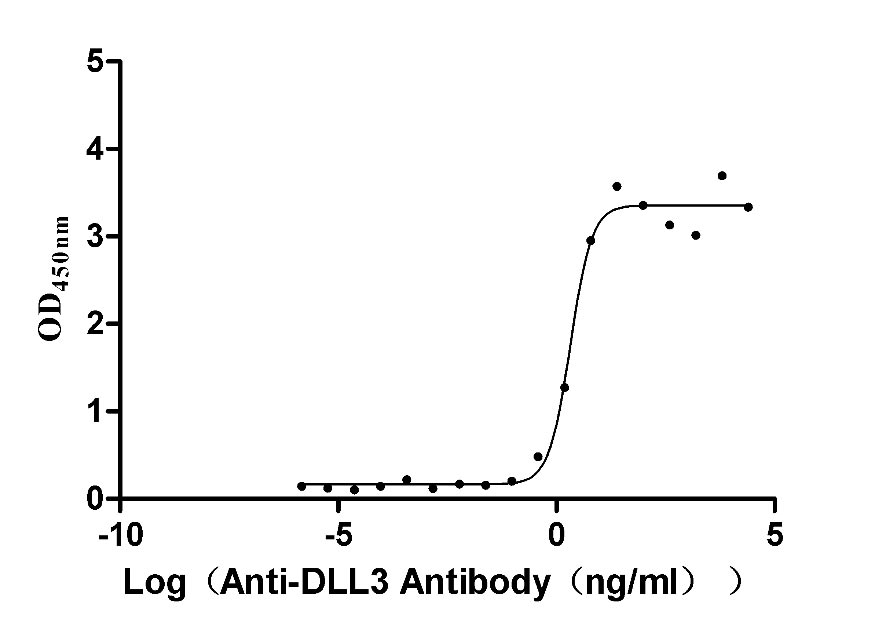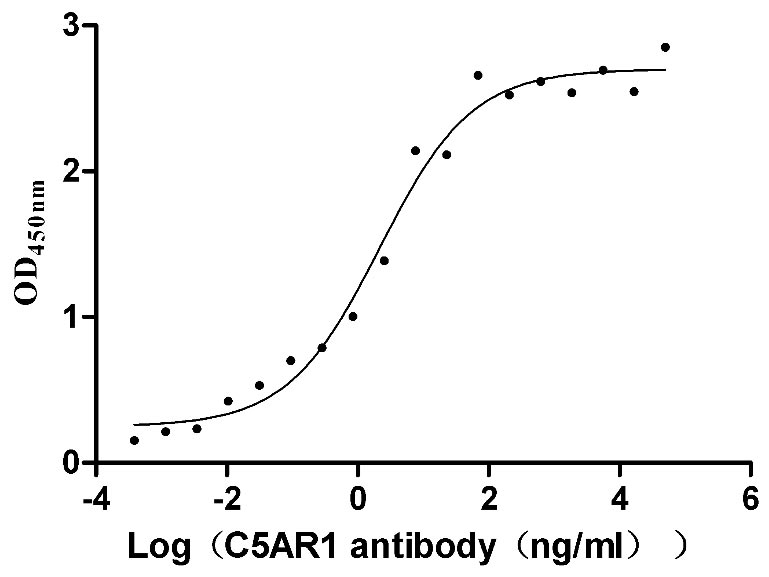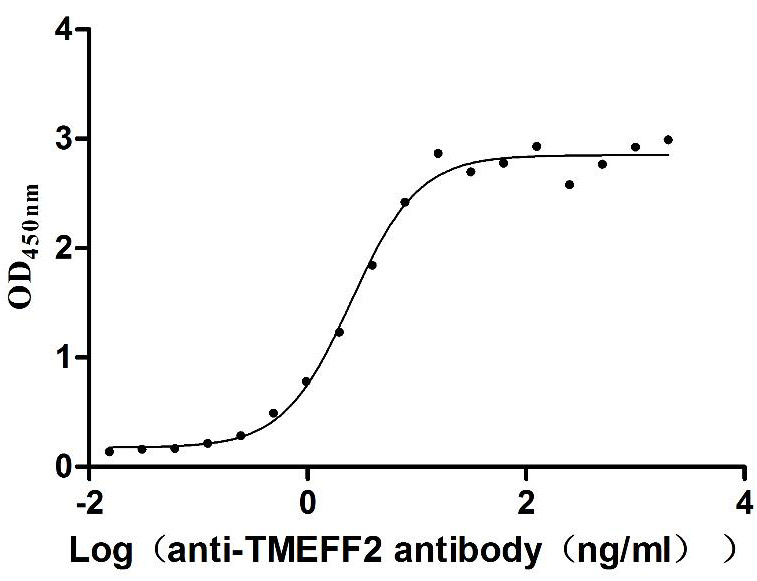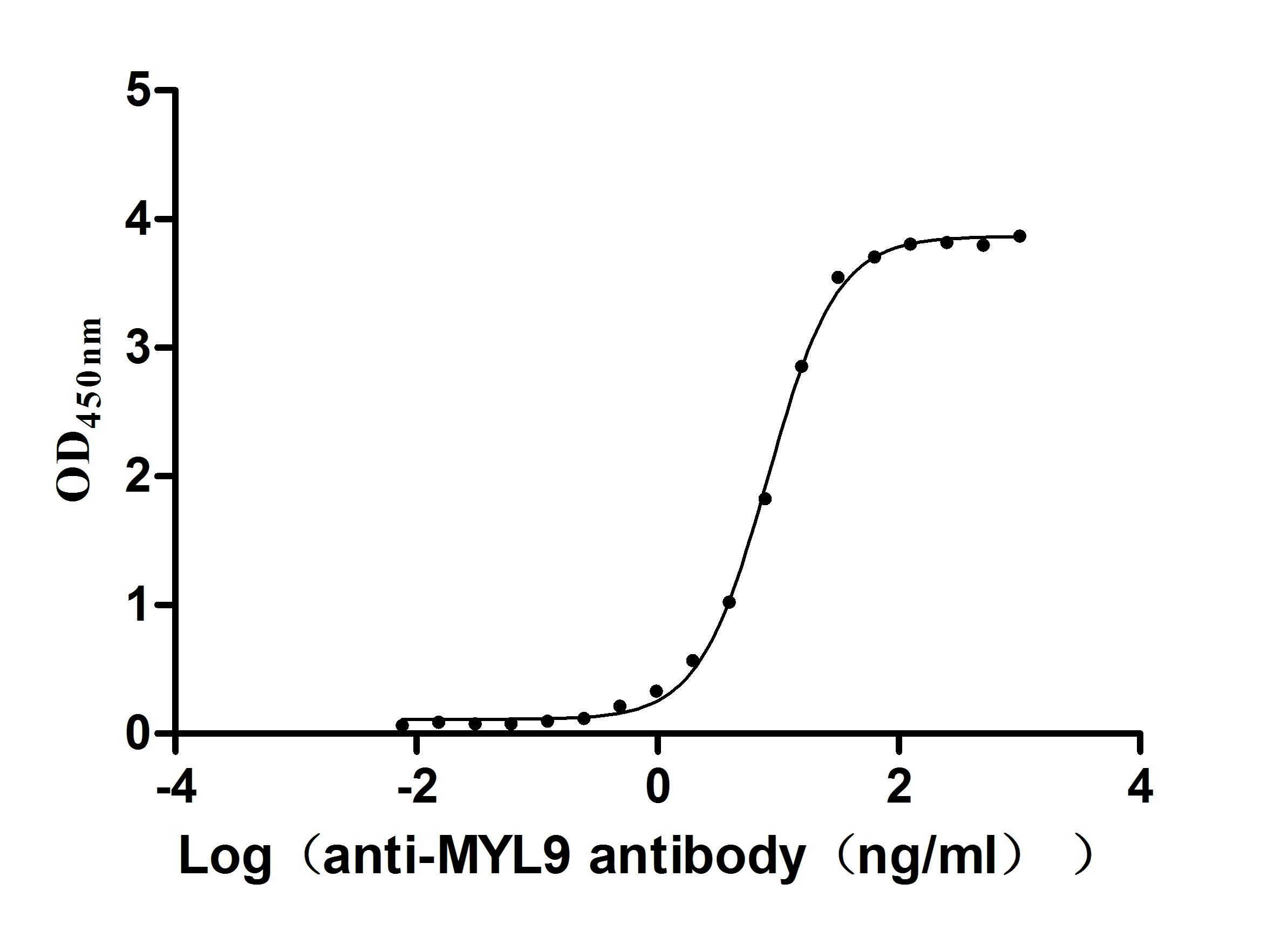Recombinant Human Lymphocyte antigen 96 (LY96)
-
中文名稱:人LY96重組蛋白
-
貨號(hào):CSB-YP013254HU
-
規(guī)格:
-
來源:Yeast
-
其他:
-
中文名稱:人LY96重組蛋白
-
貨號(hào):CSB-EP013254HU-B
-
規(guī)格:
-
來源:E.coli
-
共軛:Avi-tag Biotinylated
E. coli biotin ligase (BirA) is highly specific in covalently attaching biotin to the 15 amino acid AviTag peptide. This recombinant protein was biotinylated in vivo by AviTag-BirA technology, which method is BriA catalyzes amide linkage between the biotin and the specific lysine of the AviTag.
-
其他:
-
中文名稱:人LY96重組蛋白
-
貨號(hào):CSB-BP013254HU
-
規(guī)格:
-
來源:Baculovirus
-
其他:
-
中文名稱:人LY96重組蛋白
-
貨號(hào):CSB-MP013254HU
-
規(guī)格:
-
來源:Mammalian cell
-
其他:
產(chǎn)品詳情
-
純度:>85% (SDS-PAGE)
-
基因名:
-
Uniprot No.:
-
別名:ESOP 1; ESOP-1; ESOP1 ; LY 96; Ly-96; LY96; LY96_HUMAN; Lymphocyte antigen 96; md 2; MD 2 protein; MD2 protein; Myeloid differentiation protein 2 ; Protein MD 2; Protein MD-2; Protein MD2
-
種屬:Homo sapiens (Human)
-
蛋白長(zhǎng)度:Full Length of Mature Protein
-
表達(dá)區(qū)域:17-160
-
氨基酸序列EAQKQYWVCNSSDASISYTYCDKMQYPISINVNPCIELKGSKGLLHIFYIPRRDLKQLYFNLYITVNTMNLPKRKEVICRGSDDDYSFCRALKGETVNTTISFSFKGIKFSKGKYKCVVEAISGSPEEMLFCLEFVILHQPNSN
-
蛋白標(biāo)簽:Tag?type?will?be?determined?during?the?manufacturing?process.
The tag type will be determined during production process. If you have specified tag type, please tell us and we will develop the specified tag preferentially. -
產(chǎn)品提供形式:Lyophilized powder
Note: We will preferentially ship the format that we have in stock, however, if you have any special requirement for the format, please remark your requirement when placing the order, we will prepare according to your demand. -
復(fù)溶:We recommend that this vial be briefly centrifuged prior to opening to bring the contents to the bottom. Please reconstitute protein in deionized sterile water to a concentration of 0.1-1.0 mg/mL.We recommend to add 5-50% of glycerol (final concentration) and aliquot for long-term storage at -20℃/-80℃. Our default final concentration of glycerol is 50%. Customers could use it as reference.
-
儲(chǔ)存條件:Store at -20°C/-80°C upon receipt, aliquoting is necessary for mutiple use. Avoid repeated freeze-thaw cycles.
-
保質(zhì)期:The shelf life is related to many factors, storage state, buffer ingredients, storage temperature and the stability of the protein itself.
Generally, the shelf life of liquid form is 6 months at -20°C/-80°C. The shelf life of lyophilized form is 12 months at -20°C/-80°C. -
貨期:Delivery time may differ from different purchasing way or location, please kindly consult your local distributors for specific delivery time.Note: All of our proteins are default shipped with normal blue ice packs, if you request to ship with dry ice, please communicate with us in advance and extra fees will be charged.
-
注意事項(xiàng):Repeated freezing and thawing is not recommended. Store working aliquots at 4°C for up to one week.
-
Datasheet :Please contact us to get it.
相關(guān)產(chǎn)品
靶點(diǎn)詳情
-
功能:Binds bacterial lipopolysaccharide (LPS). Cooperates with TLR4 in the innate immune response to bacterial lipopolysaccharide (LPS), and with TLR2 in the response to cell wall components from Gram-positive and Gram-negative bacteria. Enhances TLR4-dependent activation of NF-kappa-B. Cells expressing both LY96 and TLR4, but not TLR4 alone, respond to LPS.
-
基因功能參考文獻(xiàn):
- sTLR4/MD-2 complex inhibits colorectal cancer migration and invasiveness in vitro and in vivo by lncRNA H19 down-regulation. PMID: 29036538
- MD-2 siRNA or plasmid further confirmed the efficacy of Iturin A by suppressing MD-2/TLR4 signaling pathway. The in silico docking study showed that the Iturin A interacted well with the MD-2 in MD-2/TLR4 receptor complex. Conclusively, inhibition of MD-2/TLR4 complex with Iturin A offered strategic advancement in cancer therapy. PMID: 28347875
- data confirm that engineered human cells expressing TLR4, MD2 and CD14 can respond to CMP with NF-kappaB activation and the response can be influenced by variations in CMP-mannosylation PMID: 29281684
- The observations suggest that MD-2 helps to regulate lipopolysaccharide-induced NLRP3 inflammasome activation and the inflammatory response in NR8383 cells, and likely does so by affecting MyD88/NF-kappaB signaling. PMID: 28654770
- MD2 plays an important role in induction of allergic sensitization to cat dander and common pollens relevant to human allergic diseases. PMID: 26586036
- we report that exogenous CnB is taken up by cells in a time- and concentration-dependent manner via clathrin-dependent receptor-mediated internalization. Our findings further confirm that uptake is mediated by the TLR4/MD2 complex together with the co-receptor CD14 PMID: 27090571
- In this study, a novel naturally occurring spliceosome of human MD2, termed as MD2-T3, has been identified. PMID: 27317890
- Results show that cigarette smoke may alter innate immune responses reducing the expression of the MD2, a molecule with an important role in TLR4 signaling. PMID: 26068048
- Predominantly hydrophobic interactions between MD-2 and TLR4 contribute to the stabilization of the TLR4/MD-2/metal ion complex in a conformation that enables activation. PMID: 25803856
- The intensity of the intra-amniotic inflammatory response to bacteria or perhaps to other TLR4 ligands may be facilitated through synthesis and release of sMD2 by the amniochorion. PMID: 25605324
- Three genes (LY96, IL8 DPR) were significantly downregulated over time. This finding was confirmed in a validation cohort of stroke patients (n=8). PMID: 25124890
- The study revealed the impact of specific residues and regions of MD-2 on the binding of lipolysaccharides and TLR4. PMID: 26320630
- Gene polymorphisms of MD2 and GM2A were associated with the occurrence or severity of neonatal necrotizing enterocolitis. PMID: 25816011
- In patients undergoing CABG surgery, we found genetic polymorphisms in LY96 associated with decreased risk of postoperative AF. PMID: 26385043
- Aminoarabinose residues in lipid A contribute to Burkholderia lipid A binding to the TLR4.Myeloid Differentiation Factor 2 complex. PMID: 26160169
- TLR4 along with its accessory protein MD-2 builds a heterodimeric complex that specifically recognizes lipopolysaccharides, which are present on the cell wall of gram-negative bacteria, activating the immune response. (Review) PMID: 25515751
- genetic polymorphism is associated with asthma exacerbations in children PMID: 24902762
- In monocytes of sepsis, MD-2 expression was found to be regulated by STAT1. PMID: 24858600
- Substitution of hMD-2 residue V82 with an amino acid residue with a bulkier hydrophobic side chain enables activation of TLR4/MD-2. PMID: 25203747
- This study suggests that genetic variants of LY96 may modulate the effect of smoking on carotid plaque burden. PMID: 24954085
- overexpression of MD-2s led to marked reduction in markers of tissue injury and inflammation in models of lung inflammation PMID: 25576596
- Purified monomeric ligand.MD-2 complexes reveal molecular and structural requirements for activation and antagonism of TLR4 by Gram-negative bacterial endotoxins. PMID: 24895101
- Studies suggest that myeloid differentiation 2 (MD-2) as a therapeutic target for sepsis. PMID: 24896325
- Mechanistically, engagement of MD-2 by PTX3-opsonized Aspergillus conidia activated the TLR4/Toll/IL-1R domain-containing adapter inducing IFN-beta-dependent signaling pathway converging on IL-10. PMID: 25049357
- Collectively, these data showed for the first time that, HIV-1 Tat interacts physically with high affinity with TLR4-MD2 to promote proinflammatory cytokines (TNF-alpha) and the immunosuppressive cytokine IL-10 both. PMID: 24165011
- Data suggest that zhankuic acid A (ZAA), which competes with LPS for binding to MD-2 as a TLR4/MD-2 antagonist, may be a potential therapeutic agent for gram-negative bacterial infections. PMID: 24532584
- these findings indicate that MD-2 is involved in IFN-gamma signalling and IFN-gamma-augmented MMP-1 up-regulation by LPS. PMID: 23800176
- Extracellular complex formation of TLR4 with secreted MD-2 was detectable using monoclonal antibodies. PMID: 24021278
- both oral and enteric C. concisus strains upregulated expression of TLR4 and MD-2 in HT-29 cells. PMID: 23437263
- Consistently, soluble TLR4 expressed without MD2 inhibited metal- but not LPS-induced responses, opening new therapeutic perspe PMID: 23059983
- Respiratory syncytial virus F protein requires MD-2 for the induction of the TLR4-mediated inflammatory response. PMID: 22872782
- In LOS.MD-2 complexes, one of the six fatty acyl chains of LOS is more susceptible to paramagnetic attenuation, suggesting protrusion of that fatty acyl chain from the hydrophobic pocket of MD-2, independent of association with TLR4. PMID: 22433852
- Lipopolysaccharide cytokine response was efficiently and equally abolished by MD-2 and CD14 neutralization; the response induced by whole E. coli bacteria was only modestly reduced by MD-2 neutralization, whereas CD14 neutralization was more efficient. PMID: 21948372
- have identified specific structural and dynamic features of the MD-2-endotoxin complexes that may control dimerization of TLR4 molecules. PMID: 21924775
- The association between occupational endotoxin exposure and wheeze in agricultural workers was significantly modified by genetic variants in CD14 and MD2 PMID: 21389010
- Data demonstrate that during bacterial infection, newborns amplify the TLR2-MyD88 pathway in G+ bacterial infection and the TLR4/MD2/MyD88 pathway in G- bacterial infection, implicating the innate immune pathway in response to bacterial infection. PMID: 20805788
- higher expression levels in tissue from patients with colorectal cancer PMID: 20699280
- Computational study of the interactions of the unmodified dendrimer, glucosamine, and of the partially glycosylated dendrimer with TLR4 and MD-2 using molecular docking and molecular dynamics techniques. PMID: 21738462
- tyrosine phosphorylation of MD-2 is important for signaling following exposure to lipopolysaccharide PMID: 21918188
- Cytokines can enhance TLR4 and MD-2 expressions and promote the reaction with LPS in intestinal epithelial cells. PMID: 20848773
- Interferon-gamma-induced MD-2 protein expression and lipopolysaccharide (LPS) responsiveness in corneal epithelial cells is mediated by Janus tyrosine kinase-2 activation and direct binding of STAT1 protein to the MD-2 promoter. PMID: 21572044
- In this study, we produced variants of MD-1 and MD-2 in Pichia pastoris. PMID: 21130168
- Innate immune recognition of meningococcal capsular polysaccharides by macrophages can occur via TLR2- and TLR4-MD-2 pathways. PMID: 21191086
- Neisserial lipooligosaccharides from different meningococcal and gonococcal strains have different potencies to activate NF-kappaappaB through the Toll-like receptor 4-MD-2 pathway in monocytes. PMID: 21037101
- Data conclude that these gene variants in the MD-2 gene promoter region are not associated with tuberculosis, and apparently do not play a role in susceptibility to tuberculosis in the Chinese population. PMID: 20730709
- species-specific activation of lipid IV(A) PMID: 20592019
- increased expression in intestinal epithelial cells in patients with inflammatory bowel disease PMID: 19710105
- In this study, we have identified a novel alternatively spliced isoform of human MD-2, termed MD-2 short (MD-2s), which lacks the region encoded by exon 2 of the MD-2 gene. PMID: 20435923
- Polymorphisms of the promoter region of MD-2 gene at position - 1625 C/G is correlated with MODS and sepsis after severe trauma in Chinese Han population. PMID: 19209789
- sMD-2 and sCD14 inhibit the growth of both Gram-positive and Gram-negative bacteria. PMID: 20377740
顯示更多
收起更多
-
亞細(xì)胞定位:Secreted, extracellular space. Secreted.
-
數(shù)據(jù)庫(kù)鏈接:
Most popular with customers
-
Recombinant Mouse Semaphorin-4D (Sema4d), partial (Active)
Express system: Mammalian cell
Species: Mus musculus (Mouse)
-
Recombinant Macaca fascicularis Delta-like protein 3 (DLL3), partial (Active)
Express system: Mammalian cell
Species: Macaca fascicularis (Crab-eating macaque) (Cynomolgus monkey)
-
Recombinant Human C5a anaphylatoxin chemotactic receptor 1 (C5AR1)-VLPs (Active)
Express system: Mammalian cell
Species: Homo sapiens (Human)
-
Recombinant Mouse Retinol-binding protein 4 (Rbp4) (Active)
Express system: Mammalian cell
Species: Mus musculus (Mouse)
-
Recombinant Human Dickkopf-related protein 1 (DKK1) (Active)
Express system: Mammalian cell
Species: Homo sapiens (Human)
-
Recombinant Human Tomoregulin-2 (TMEFF2), partial (Active)
Express system: Mammalian cell
Species: Homo sapiens (Human)
-
Recombinant Human Myosin regulatory light chain 12B(MYL12B) (Active)
Express system: E.coli
Species: Homo sapiens (Human)
-
Recombinant Macaca fascicularis Cadherin 6(CDH6),partial (Active)
Express system: Mammalian cell
Species: Macaca fascicularis (Crab-eating macaque) (Cynomolgus monkey)






-AC1.jpg)













